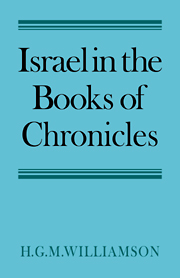Book contents
- Frontmatter
- Contents
- Foreword
- List of Abbreviations
- 1 Introduction
- PART ONE The Extent of the Chronicler's Work
- PART TWO The Concept of Israel in the Books of Chronicles
- 7 1 Chronicles 1–2 Chronicles 9
- 8 The Divided Monarchy (2 Chronicles 10–28)
- 9 Hezekiah to the Babylonian Exile (2 Chronicles 29–36)
- 10 Conclusions
- Bibliography
- Index of Passages Cited
- Index of Modern Authors
- General Index
9 - Hezekiah to the Babylonian Exile (2 Chronicles 29–36)
Published online by Cambridge University Press: 26 February 2010
- Frontmatter
- Contents
- Foreword
- List of Abbreviations
- 1 Introduction
- PART ONE The Extent of the Chronicler's Work
- PART TWO The Concept of Israel in the Books of Chronicles
- 7 1 Chronicles 1–2 Chronicles 9
- 8 The Divided Monarchy (2 Chronicles 10–28)
- 9 Hezekiah to the Babylonian Exile (2 Chronicles 29–36)
- 10 Conclusions
- Bibliography
- Index of Passages Cited
- Index of Modern Authors
- General Index
Summary
It is evident that, with the Israelite population partially reunited in its depressed state, the Chronicler's interpretation of Hezekiah's reign will be of paramount importance. To maintain continuity of argument, therefore, we shall treat this subject first in this chapter, before going on to deal with other aspects of his understanding of Israel during this period.
HEZEKIAH IN THE BOOKS OF CHRONICLES
In his recent book Untersuchungen zur Theologie des chronistischen Geschichtswerky, R. Mosis has suggested that the Chronicler adopted the reigns of Saul (1 Chr. 10), David (1 Chr. 11–29) and Solomon (2 Chr.1–9) as paradigms of the three possible situations in which the Israel of later periods might find herself (p. 165). Since the period of Solomon is thought to have been portrayed by the Chronicler as one of final blessing, for the return of which later Israel can only hope in faith, it follows that the subsequent kings of Israel are patterned only on Saul or David. It is not surprising, therefore, that in the course of his analysis of this later period, Mosis should write: ‘Wie Ahas als ein zweiter Saul erscheint, stellt der Chr in Hiskija einen zweiten David dar’ (p. 189).
This conclusion is based on three pieces of evidence.
(a) 2 Chr. 29: 2 says that ‘Hezekiah did that which was right in the eyes of the Lord, according to all that David his father had done.’
(b) Hezekiah's cleansing of the temple and his Passover celebration are thought to parallel the restoration of the cult after the exile as described in Ezr. 1–6, which Mosis categorizes as ‘Davidic.’
[…]
- Type
- Chapter
- Information
- Israel in the Books of Chronicles , pp. 119 - 131Publisher: Cambridge University PressPrint publication year: 1977



